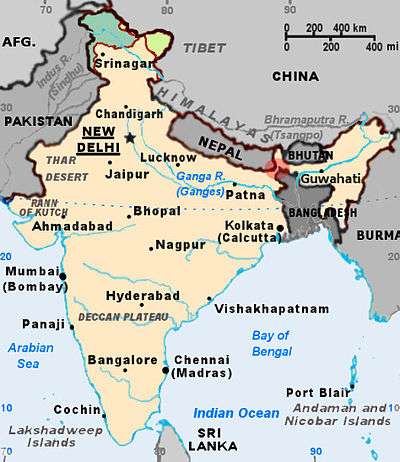Siliguri Corridor
The Siliguri Corridor (also known as the Chicken's Neck) is a narrow stretch of land of about 22 kilometres (14 mi) width, located in the Indian state of West Bengal, that connects India's northeastern states to the rest of India, with the countries of Nepal and Bangladesh lying on either side of the corridor. The Kingdom of Bhutan lies on the northern side of the corridor. The Kingdom of Sikkim formerly lay on the northern side of the corridor, until its merger with India in 1975.

The city of Siliguri, in the state of West Bengal, is the major settlement in this area and the central node that connects Bhutan, Nepal, Bangladesh, Sikkim, Darjeeling hills, Northeast India and the rest of India.
History
The Siliguri Corridor was created in 1947 after the partition of Bengal. The kingdom of Sikkim formerly lay on the northern side of the corridor, until its union with India in 1975 via a publicly held referendum.[1][2] This gave India a buffer to the north of the Siliguri Corridor and consolidated India's control over the western side of the Chinese Chumbi Valley.
Geostrategic importance
The Siliguri Corridor is an especially important and sensitive territory for India, formed by the creation of East Pakistan (now Bangladesh) in 1948. The partition of India occurred as a result of hostility between the Indian National Congress and the Muslim League. From the very beginning, the relationship between these two new states was marked by hostilities and confrontations.
The formation of East Bengal created a geographical barrier to the northeastern part of India. The narrow Siliguri Corridor, which at one point is less than 27 kilometres (17 mi) wide, remained as the only bridge between the northeastern part of India and the rest of the country.
Wedged between Bangladesh to the south and west and China to the north, the region has no access to the sea closer than Kolkata, on the other side of the corridor.[3] Between Sikkim and Bhutan lies the Chumbi Valley, a dagger-like slice of Tibetan territory. A Chinese military advance of less than 130 kilometres (81 mi) would cut off Bhutan, part of West Bengal and all of North-East India, an area containing almost 50 million people. This situation arose during the war between India and China in 1962.[4]
India has embarked on a slew of projects, such as construction of India-China Border Roads and Advance Landing Ground (AGLs), Northeastern India connectivity and Look-East transnational connectivity projects to create multiple alternatives to Silliguri corridor, including through Bangladesh and sea, to mitigate the risk of being cut off.
Current situation
As a sensitive area amidst three countries, the strip is heavily patrolled by the Indian Army, the Assam Rifles, the Border Security Force and the West Bengal Police.
All land transportation between mainland India and its far northeastern states uses this circuitous corridor, as there is no free-trade agreement between Bangladesh and India. The Tetulia Corridor, an alternative to the Siliguri Corridor, is proposed under Article VIII of the India–Bangladesh Trade Agreement 1980, which states that "The two governments agree to make mutually beneficial arrangements for the use of their waterways, railways and roadways for commerce between the two countries and for passage of goods between two places in one country through the territory of the other". However, the proposal is still in the initial stages of negotiation.
The route has a major broad gauge railway line. Electrification of this double-track corridor is in progress with assistance from Central Organization for Railway Electrification (CORE). Additionally, the old metre gauge line (recently converted to a 1.676 metres (5 ft 6.0 in) broad-gauge line) connects Siliguri Junction with Islampur in North Dinajpur District of West Bengal, via Bagdogra (the only airport of national interest in the corridor) and the bordering towns of Adhikari, Galgalia, Thakurganj, Naxalbari and Taiabpur with Nepal. National Highway 10 connects Siliguri to Guwahati in Assam, which is the most critical highway in the region, owing to insurgents operating in the vicinity.[5]
Notes
- "Sikkim Votes On Indian Merger". Daytona Beach Morning Journal. 15 April 1975. Retrieved 28 January 2018.
- "Sikkim Voters OK Merger With India". Sarasota Herald-Tribune. 16 April 1975. Retrieved 28 January 2018.
- Marcus Franda, "Bangladesh, The First Decades", South Asian Publishers Pvt. Ltd, New Delhi, 1982, p-126
- Partha S. Ghosh, "Cooperation and Conflict in South Asia", UPL, Dhaka, 1989, p-43
- Gokhale, Nitin A. (13 July 1998). "Chicken's Neck, All choked up". Outlook. Retrieved 27 February 2011.